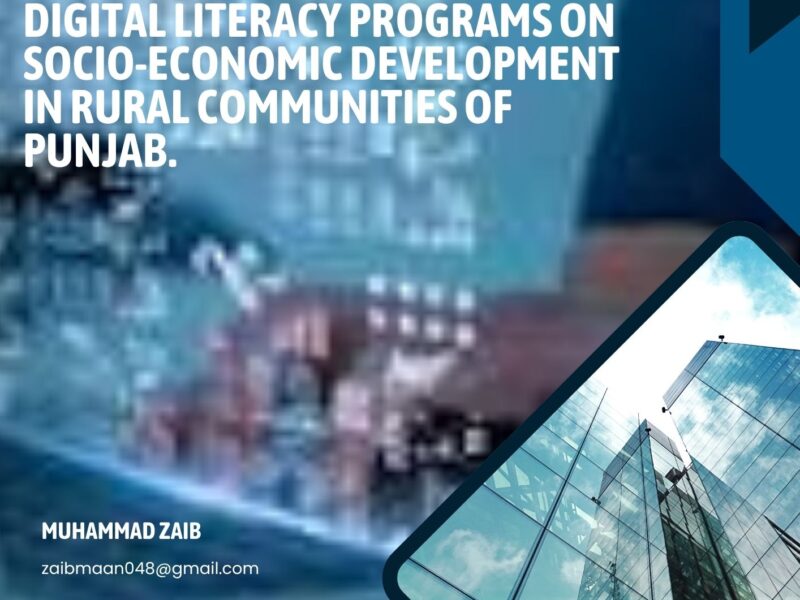1. Introduction
In an era where digital technology drives global progress, rural communities in Punjab, Pakistan, remain disproportionately excluded from the digital revolution. While urban centers benefit from high-speed internet, e-governance, and digital economies, rural areas face systemic barriers—limited infrastructure, low literacy rates, and economic deprivation. However, targeted digital literacy programs are proving to be a game-changer, offering pathways to education, employment, and socio-economic mobility.
This article provides an in-depth analysis of how digital literacy initiatives are transforming rural Punjab, examining their impact on education, economic opportunities, and social development, while also addressing persistent challenges and policy recommendations for scaling these efforts.
2. Understanding the Digital Divide in Rural Punjab
2.1 Infrastructure Deficits
Rural Punjab suffers from chronic electricity shortages and limited internet penetration. According to the Pakistan Telecommunication Authority (PTA, 2023), only 28% of rural Punjab has access to 3G/4G networks, compared to 72% in urban areas. Many villages lack computer labs, and smartphones remain unaffordable for low-income families.
2.2 Educational Gaps
Public schools in rural Punjab often lack:
• Trained IT teachers
• Computer labs or functional devices
• Updated curricula incorporating digital skills
• A British Council (2019) study found that only 15% of rural schools had computers, and fewer than 10% of teachers were digitally literate.
2.3 Socio-Cultural Barriers
• Gender disparities: Cultural norms restrict women’s access to technology.
• Technophobia: Older generations resist digital adoption due to unfamiliarity.
• Language barriers: Most digital content is in English, excluding Urdu/Punjabi speakers.
3. Digital Literacy Initiatives: Key Components and Implementation
3.1 Government-Led Programs
• Punjab Information Technology Board (PITB): Established Digital Punjab centers offering free IT training.
• Prime Minister’s Digital Pakistan Initiative: Subsidized laptops and internet for students.
3.2 NGO and Private Sector Contributions
• The Citizens Foundation (TCF): Digital labs in 300+ rural schools.
• Jazz Digital Pakistan: Mobile literacy programs for women.
3.3 Curriculum and Skill Development
Programs focus on:
• Basic computer skills (Word, Excel, browsing)
• E-commerce (Daraz, Facebook Marketplace training)
• Freelancing (Upwork, Fiverr workshops)
4. Educational Advancements Through Digital Literacy
4.1 Access to Online Learning Platforms
Platforms like Coursera, DigiSkills.pk, and YouTube tutorials enable students to learn coding, graphic design, and business skills.
4.2 Teacher Training and Digital Pedagogy
• Google’s Digital Garage trained 12,000+ teachers in Punjab.
• Virtual classrooms via Zoom and Google Meet now supplement traditional teaching.
4.3 Case Study: A Success Story from Vehari District
A 2022 pilot project in Vehari equipped 500 students with tablets and Wi-Fi. Within a year:
• School attendance rose by 40%
• Test scores improved by 25%
• 5 students secured online freelancing jobs
5. Economic Empowerment and Livelihood Opportunities
5.1 E-Commerce and Digital Market Access
Farmers using AgriMart Pakistan saw 30% higher profits by eliminating middlemen.
5.2 Freelancing and Remote Work
Punjab’s youth are earning $500–$1,000/month via Upwork (PITB, 2023).
5.3 Agricultural Technology Adoption
• Crop monitoring apps reduce water waste by 20%.
• Weather alert SMS services help farmers avoid losses.
6. Social Impact: Community Development and Gender Inclusion
6.1 Women’s Digital Empowerment
• 50,000 women trained in digital skills via Punjab’s Women’s Digital Initiative.
• Female-run home businesses increased by 60% (UN Women, 2022).
6.2 Civic Engagement and Awareness
• Ehsaas Program apps help villagers access welfare schemes.
• Telemedicine platforms connect rural patients to doctors.
7. Challenges in Implementation
7.1 Internet Connectivity and Electricity Issues
• Load-shedding disrupts online classes.
• 4G coverage gaps persist in remote areas.
7.2 Financial and Cultural Constraints
• Device affordability: Tablets cost 1–2 months’ wages.
• Male family members often control women’s internet access.
8. Policy Recommendations
1. Expand broadband infrastructure to remote villages.
2. Subsidize smartphones/tablets for low-income families.
3. Localize digital content in Urdu/Punjabi.
4. Gender-sensitive programs to increase female participation.


